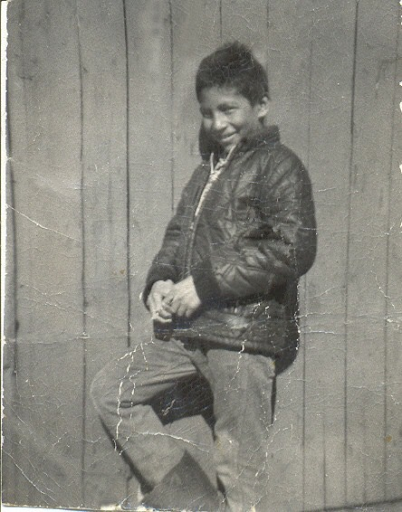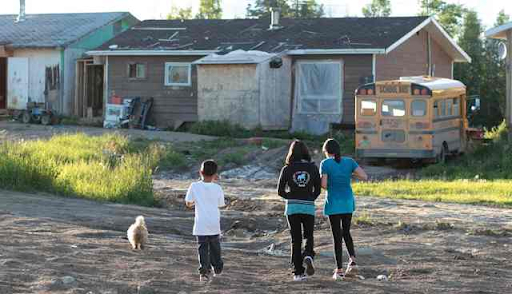The Mount Elgin residential school near St. Thomas, 1848-1948. (NEWMARKETTODAY.CA)
By: Simoni Parikh, Stephie Lee Varghese, Julia Li
Approximately one hundred-thirty schools, one-hundred-fifty thousand children, and six thousand deaths.
For over a century, the Indigenous People were told that their way of life, traditions, language, and clothing would not be accepted in society. The Federal Government intended to make the Indigenous People less dependent on public funds and as a solution, the Canadian Government planned to preoccupy them with the idea of an education system.
The Government and the Christian Churches created Residential Schools with the purpose of converting Indigenous children to fit into Canadian Society. Although Indigenous Peoples hoped to be provided with education for their children and future generations, Residential Schools were not the kind of establishments that they had hoped to be provided with. Along with the concerns of the Government and Churches’ intentions, before any decisions were made, the Indigenous children were being taken away from their families. At the Residential Schools, they were abused, sexually assaulted, punished, put under poor living conditions, and forced to forget their culture and traditions, all at a young age. For over 100 years, more than 150,000 Indigenous children (Forbes 2021 ) were forcibly taken from their families and put into residential schools. They were imposed with new names, haircuts, and different identification numbers. Their identity and their culture, all became nothing but a number.
Many people living during the tragic era of residential schools believed that Christianity and civilization went hand in hand together, meaning that society would not be able to function without this so-called symbiotic relationship. According to a report from the Alberta Methodist Church, “The Indian is the weak child in the family of our nation and for this reason, presents the most earnest appeal for Christian sympathy and cooperation” (Facing History & Ourselves n.d).
However, the Indigenous people had refused to renounce their traditions and beliefs within their basic human rights.
Hence, residential schools were founded to ‘eradicate the Indian within the child’ for them to become assimilated into society, ripping families apart to ensure that the Indigenous culture could not be passed down between generations.
Later, the government enabled Anglican and Roman Catholic Churches to manage residential schools. The churches operated residential schools as society believed that Christianity and civilization were closely knitted together. However, instead of providing a nurturing community for the Indigenous children, there were immense amounts of torture that had left a permanent scar in the lives of many.

Charlie Wenjack (Canadian Encyclopedia 2016)
Chanie Wenjack, an Anishinaabe boy from Ontario, was sent more than 600 kilometres away to Cecilia Jeffrey Indian Residential School and was given the name 'Charlie.' At the age of nine, he was separated from his three sisters and was placed in grade one.
On the afternoon of October 16, 1966, Charlie Wenjack and his two friends escaped from the residential school. After hours of running, it soon became a battle of life and death. He had no food, no warmth, but this quiet ambition— to go back home.
On an early morning of October 23, 1966, a week after he had first escaped the residential school, a railway worker discovered his body beside the tracks. Charlie Wenjack had died of exposure to cold and hunger. Today, we remember him as a twelve-year-old boy, who had run sixty kilometres from the Cecilia Jeffrey Residential School.
Yet as history progresses, the mystery of why Charlie Wenjack ran away from the residential school remains obscure.
His friends said that he wanted to see his father, whereas his sister said he ran away because of sexual assault and physical abuse. In an investigation upon his death, the jury and journalist stated that Charlie Wenjack had run away because he was lonely.
Wenjack's death in 1966 received national attention and has now become a symbol of resistance to the power of colonization in Canada. His story has led to eventual legislative reforms and lawsuits, including the Indian Residential Schools Settlement Agreement and the Truth and Reconciliation Commission.
In essence, the Indigenous children who were forced into residential schools were stripped of their humanity and put through unfathomable torture. All the vibrant colour was drained from their peaceful lives, only to be replaced by the darkest black.
The Canadian Charter of Rights and Freedom was created on April 17, 1982, with the vision of uniting a nation based on equality. As mentioned by the Government of Canada, “...[The Charter] protects equality, the Charter also allows for certain laws or programs that aim to improve the conditions of disadvantaged individuals or groups. For example, programs aimed at improving employment opportunities for women, Indigenous peoples… are allowed under subsection 15(2)” (Government of Canada 2020).
However, according to Amnesty International, an organization working for human rights, “Indigenous families in Canada continue to face widespread impoverishment, inadequate housing, food insecurity, ill-health and unsafe drinking water.” They also state that “...funding for many basic services for Indigenous peoples is often less than what is provided in predominantly non-Indigenous communities” (Amnesty International n.d). Although the Government of Canada has apologized to the Indigenous community for past mistakes, there is much work to be done to completely reconcile with the community. Even today, the Indigenous community is mistreated and affected by the remnants of the past.
Honouring the Indigenous community and ensuring that they receive justice for mistreatment over the past century is a minimum requirement considering the immense hardship and trauma they have had to endure.

First Nations Housing On Reserve (CICH n.d.)
As the future leading generation, striving towards the improvement of Indigenous communities and lifestyles must be a top priority. You may help by donating to organizations that support Indigenous communities, reading Indigenous literature, watching Indigenous films, and listening to Indigenous music to witness the beauty of their culture and share this knowledge with others during conversations or through social media. You could read the Truth and Reconciliation report to gain more knowledge about the horrors faced by the Indigenous community or write to elected representatives and discuss taking action for the betterment of the community.
Kingsley Shacklebolt, from the Harry Potter series, once said, “We're all human, aren't we? Every human life is worth the same, and worth saving” (Rowling 359). Similarly, the Indigenous community deserves to lead a life without discrimination, one where they have access to basic human necessities and are free to embrace their culture.
Note To Reader
The one thing that we hope for in the future is that this article will be one to remember as more events of our dark past are revealed in the future. A common phrase that is heard amongst this generation is “Why should we care? Why should we care about something that has already happened?”
If it was your family and ancestors who had been affected, would you have cared? If your answer is yes, then why couldn’t you express the same amount of sentiment for another community that has suffered?
If your answer is “It does not affect me.” We could argue that you are being unreasonable. One way or another, the actions we take, and the actions we don’t take affect our future. Our future relies on us. Choosing to be a bystander and avoiding supporting equality for all people will be the downfall of humanity and our society.
We are all human. At the end of the day, all we have is each other. We may not see the point in talking about something that has happened in the past but we must understand that if we don’t help each other, we cannot move forward without the feeling of unity in our lives. There is immense power in unity and diversity.
There are no ‘better’ people or a hierarchy of race. There should be no place of hate in this world based purely on the topic of ethnicity. We are all climbing the same ladder and must work together to reach the top in order to have a well-working society.
Choosing to ignore this mindset will only lead to our destruction with no one else to blame but ourselves.
We cannot simply erase the past but we can make amends and do better for the upcoming generations. Please do your part. Spread awareness, lend a helping hand, and help bring people up rather than bringing them down.
“If you are a former residential school student in distress, or have been affected by the residential school system and need help, you can contact the 24-hour Indian Residential Schools Crisis Line at 1-866-925-4419, or the Indian Residential School Survivors Society toll-free line at 1-800-721-0066,” (CTVNews 2020).
Works Cited
"5 Ways You Can Educate Yourself and Support Indigenous Communities in Canada.” Global Citizen, www.globalcitizen.org/en/content/how-to-support-indigenous-communities-canada/?template=next.
5th: ELLE Canada- Jul, et al. “Here's How You Can Be a Genuine Ally to Indigenous Communities in Canada.” Elle Canada, www.ellecanada.com/culture/society/heres-how-you-can-be-a-genuine-ally-to-indigenous-communities-in-canada. “Southern Ontario Was Home to 2 Notorious Residential Schools.”
“Canada Mourns as Remains of 215 Children Found at Indigenous School.” BBC News, BBC, 29 May 2021, www.bbc.com/news/world-us-canada-57291530.
Carley, Georgia. “Chanie Wenjack.” The Canadian Encyclopedia, 7 Apr. 2016, www.thecanadianencyclopedia.ca/en/article/charlie-wenjack.
Forbes, Ryan. “Photos: A history of residential schools in Kenora.” KenoraOnline, 1 June, 2021 https://www.kenoraonline.com/articles/photos-a-history-of-residential-schools-in-kenora
Heritage, Canadian. “Government of Canada.” Canada.ca, / Gouvernement Du Canada, 8 June 2020, www.canada.ca/en/canadian-heritage/services/how-rights-protected/guide-canadian-charter-rights-freedoms.html.
“HOW TO HELP FIRST NATIONS COMMUNITIES IN CANADA True North Aid.” True North Aid, 18 June 2020, truenorthaid.ca/how-to-help-first-nations/.
“Indigenous Peoples in Canada.” Amnesty International Canada, 22 Aug. 2016, www.amnesty.ca/our-work/issues/indigenous-peoples/indigenous-peoples-in-canada.
“Non-Indigenous People - Here's What You Can Do, Right Now.” The Discourse., 2 June 2021, thediscourse.ca/okanagan/non-indigenous-people-heres-what-you-can-do-right-now.
“Residential Schools of Canada.” Religion and Public Life at Harvard Divinity School, rpl.hds.harvard.edu/religion-context/case-studies/violence-peace/residential-schools-canada.
“The Role of the Churches.” Facing History and Ourselves, www.facinghistory.org/stolen-lives-indigenous-peoples-canada-and-indian-residential-schools/chapter-3/role-churches.
Rowling, Joanne K. Harry Potter and the Deathly Hallows. Bloomsbury, 2014.
“Sask. First Nation Announces Hundreds of Unmarked Graves Found at Former Residential School Site | CBC News.” CBCnews, CBC/Radio Canada, 24 June 2021, www.cbc.ca/news/canada/saskatchewan/cowessess-graves-unmarked-residential-school-marieval-1.6077797.
“First Nations Housing On Reserve – The Health of Canada's Children and Youth.” La Santé Des Enfants Et Des Jeunes, cichprofile.ca/module/7/section/4/page/first-nations-housing-on-reserve/.
MacLeod, Richard. “Southern Ontario Was Home to 2 Notorious Residential Schools.”
NewmarketToday.ca, 19 June 2021, 11:30 AM, www.newmarkettoday.ca/remember-this/southern-ontario-was-home-to-2-notorious-residential-schools-3889982.
French, Cameron. “How International Media Covered the Discovery of 751 Unmarked Graves near Former Sask. Residential School.” CTVNews, CTV News, 25 June 2021, www.ctvnews.ca/canada/how-international-media-covered-the-discovery-of-751-unmarked-graves-near-former-sask-residential-school-1.5485467.

